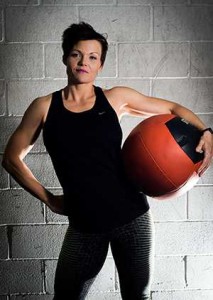I always feel so grateful for friends who don’t even hesitate when I ask them for a guest post. I’m kicking off my annual (?) blog hiatus with an inspiring post from someone I 100% trust to give it to you straight. Michelle’s own journey with provides a great mental game plan on how to rehab an injury – Pamela
At some point in our fitness journey, we will all more than most likely embark on an injury. Now, this could be an injury due to poor movement patterns, one due to lack of body control, or just something that happens out of the blue when we aren’t in tune with our innermost gut feelings. Irregardless of how the injury came to be, I have some tips and experience points to share today that will get you back AND better than ever.
Recently, I underwent hip surgery due to a bone deformity that caused several tears to the cartilage in my hip. I’ll spare you the surgery details, but it was pretty awesome. After surgery, I was assigned an awesome physical therapist for three months. The goal was to get my mobility back, but I have ended up with a whole lot more.
Now, I have to give you the point of view of an active individual here: I was all for laying around and watching Netflix during recovery….for the first few days. After that, it becomes extremely irritating that my body betrayed me and won’t even get it together so I can go be awesome and stuff! Both my surgeon and therapist kept reminding me of one key thing: TRUST THE PROCESS.
Coming back from an injury (or just starting your fitness journey) is very much a process. It requires time and specific training. You can’t jump into the deep end of the pool if you haven’t even learned the basics of keeping your head above water. Trust can be a very hard thing to do, especially for fitness professionals or those who have been doing this for a long time; however, it is this trust that will help get your through the rough stuff.
Personally, I think it’s crazy to worry about weight (loss or gain) during recovery. Obviously, you don’t want to go off the deep end either way, but post-surgery is not the best time to hop on the scale daily and see if you’ve dropped those last 10 elusive pounds. A better way to chart your progress would be to set movement goals with your therapist. I started out wanting to work with the sled, so my therapist charted a track to get me there. And guess what? I was sled pulling the week I got off crutches! When you have a goal, you’re more likely to trust the process. Are you noticing the trend here?
So, how do you set attainable goals when dealing with an injury? Enlist the help of your therapist. Talk with them about what you want to be doing 4, 6, 8 and 12 months from now. Even if you won’t be with them that long, they will help you set attainable goals and know when and how to progress.
One of the biggest things I’ve noticed while sharing a therapy room with loads of other patients is the ATTITUDE. You really will only get out what you put in to your recovery. COMPLIANCE is key to any type of program. If you have set goals with your therapist, mapped out a plan, are trusting the process, and are being fully compliant with your homework, you will see and feel a difference in your body. I know it’s hard because for the first few weeks of my recovery I was limited to lying on my bed and doing isometric contractions……for weeks people! That gets really boring, BUT I was trusting and committed and I was able to move forward without causing more harm to my body.
So, what are the keys to seeing results?
- Trust the process.
- Chart Your Progress.
- Set ATTAINABLE Goals.
- Commit to Compliance.
These 4 keys will unlock your potential in recovery as well as ANY fitness adventure you choose.
If you aren’t currently working with a trainer, I would ask that you consider getting a consult from a qualified and trusted trainer either near you or online. If you’re in need of corrective exercise therapy, ask your trainer for a recommendation. Keep tracking your progress and be willing to back off as needed. Last, keep a positive mindset. You can do this by looking back at your progress, keeping a gratitude journal, or simply offering verbal THANKS that you are still in the game.
Just remember, as long as you’re moving, you’re moving forward.




